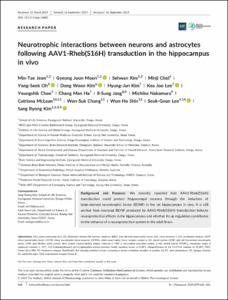Neurotrophic interactions between neurons and astrocytes following AAV1-Rheb(S16H) transduction in the hippocampus in vivo
- Title
- Neurotrophic interactions between neurons and astrocytes following AAV1-Rheb(S16H) transduction in the hippocampus in vivo
- Author(s)
- Jeon, Min-Tae ; Moon, Gyeong Joon ; Kim, Sehwan ; Choi, Minji ; Oh, Yong-Seok ; Kim, Dong Woon ; Kim, Hyung-Jun ; Lee, Kea Joo ; Choe, Youngshik ; Ha, Chang Man ; Jang, Il-Sung ; Nakamura, Michiko ; McLean, Catriona ; Chung, Won-Suk ; Shin, Won-Ho ; Lee, Seok-Geun ; Kim, Sang Ryong
- DGIST Authors
- Jeon, Min-Tae ; Moon, Gyeong Joon ; Kim, Sehwan ; Choi, Minji ; Oh, Yong-Seok ; Kim, Dong Woon ; Kim, Hyung-Jun ; Lee, Kea Joo ; Choe, Youngshik ; Ha, Chang Man ; Jang, Il-Sung ; Nakamura, Michiko ; McLean, Catriona ; Chung, Won-Suk ; Shin, Won-Ho ; Lee, Seok-Geun ; Kim, Sang Ryong
- Issued Date
- 2020-02
- Type
- Article
- Article Type
- Article
- Keywords
- TYROSINE KINASE-B ; PARKINSONS-DISEASE ; DOPAMINE NEURONS ; MESSENGER-RNA ; GENE-THERAPY ; FULL-LENGTH ; MOUSE MODEL ; BRAIN ; EXPRESSION ; RECEPTOR
- ISSN
- 0007-1188
- Abstract
- Background and Purpose: We recently reported that AAV1-Rheb(S16H) transduction could protect hippocampal neurons through the induction of brain-derived neurotrophic factor (BDNF) in the rat hippocampus in vivo. It is still unclear how neuronal BDNF produced by AAV1-Rheb(S16H) transduction induces neuroprotective effects in the hippocampus and whether its up-regulation contributes to the enhance of a neuroprotective system in the adult brain. Experimental Approach: To determine the presence of a neuroprotective system in the hippocampus of patients with Alzheimer's disease (AD), we examined the levels of glial fibrillary acidic protein, BDNF and ciliary neurotrophic factor (CNTF) and their receptors, tropomyocin receptor kinase B (TrkB) and CNTF receptor α(CNTFRα), in the hippocampus of AD patients. We also determined whether AAV1-Rheb(S16H) transduction stimulates astroglial activation and whether reactive astrocytes contribute to neuroprotection in models of hippocampal neurotoxicity in vivo and in vitro. Key Results: AD patients may have a potential neuroprotective system, demonstrated by increased levels of full-length TrkB and CNTFRα in the hippocampus. Further AAV1-Rheb(S16H) transduction induced sustained increases in the levels of full-length TrkB and CNTFRα in reactive astrocytes and hippocampal neurons. Moreover, neuronal BDNF produced by Rheb(S16H) transduction of hippocampal neurons induced reactive astrocytes, resulting in CNTF production through the activation of astrocytic TrkB and the up-regulation of neuronal BDNF and astrocytic CNTF which had synergistic effects on the survival of hippocampal neurons in vivo. Conclusions and Implications: The results demonstrated that Rheb(S16H) transduction of hippocampal neurons could strengthen the neuroprotective system and this intensified system may have a therapeutic value against neurodegeneration in the adult brain. © 2019 The Authors. British Journal of Pharmacology published by John Wiley & Sons Ltd on behalf of British Pharmacological Society
- Publisher
- Wiley-Blackwell
- Related Researcher
-
-
Oh, Yong-Seok
- Research Interests Monoaminergic regulation of the CNS and mood;anxiety disorder; 모노아민 (세로토닌; 도파민)에 의한 신경조절과 기분;불안 장애 기전 연구
-
- Files in This Item:
-
 기타 데이터 / 13.1 MB / Adobe PDF
download
기타 데이터 / 13.1 MB / Adobe PDF
download
- Appears in Collections:
- Department of Brain Sciences Molecular Psychiatry Lab 1. Journal Articles



